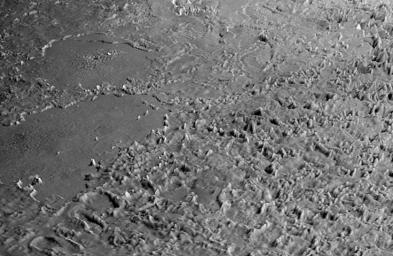
|
Triton’s “Cantaloupe” Terrain
- Click the image above for a larger view
- Full-Res JPEG (836 x 545) (107.6 kB)
- Full-Res TIFF (836 x 545) (456.3 kB)
Caption:
This view of the volcanic plains of Neptune's moon Triton was produced using topographic maps derived from images acquired by NASA's Voyager spacecraft during its August 1989 flyby, 20 years ago this week.
Triton, Neptune's largest moon, was the last solid object visited by the Voyager 2 spacecraft on its epic 10-year tour of the outer solar system. The rugged terrain in the foreground is Triton's infamous cantaloupe terrain, most likely formed when the icy crust of Triton underwent wholesale overturn, forming large numbers of rising blobs of ice (diapirs). The numerous irregular mounds are a few hundred meters (several hundred feet) high and a few kilometers (a few miles) across and formed when the top of the crust buckled during overturn. The large walled plains are of unknown origin, although the irregular pit in the center of the background walled plain may be volcanic in nature. These plains are approximately 152 meters (500 feet) deep and 200 to 250 kilometers (124 to 155 miles) across.
The surface of Triton is very rugged, scarred by rising blobs of ice, faults and volcanic pits and lava flows composed of water and other ices. The surface is also extremely young and sparsely cratered, and could be geologically active today. This scene is on the order of 150 meters (500 feet) across and is taken from a new flyover movie across the equatorial region of Triton commemorating the Voyager anniversary of that flyby. Vertical relief has been exaggerated by a factor of 25 to aid interpretation.
Background Info:
The raw data from which this product was developed were retrieved from the Planetary Data System's data archives. The Jet Propulsion Laboratory, a division of the California Institute of Technology in Pasadena, manages the mission for NASA's Science Mission Directorate, Washington, D.C. The Voyager spacecraft and its two onboard cameras were designed, developed and assembled at JPL. This image was processed by Paul Schenk ( http://www.lpi.usra.edu/lpi/schenk/ ) at the Lunar and Planetary Institute.
Cataloging Keywords:
| Name | Value | Additional Values |
|---|---|---|
| Target | Triton | |
| System | Neptune | |
| Target Type | Satellite | |
| Mission | Voyager | |
| Instrument Host | Cassini Orbiter | Voyager 2 |
| Host Type | Orbiter | Flyby Spacecraft |
| Instrument | Imaging Science Subsystem (ISS) | |
| Detector | ||
| Extra Keywords | Crater, Grayscale, Volcano, Water | |
| Acquisition Date | ||
| Release Date | 2009-08-25 | |
| Date in Caption | ||
| Image Credit | NASA/JPL/Universities Space Research Association/Lunar & Planetary Institute | |
| Source | photojournal.jpl.nasa.gov/catalog/PIA12186 | |
| Identifier | PIA12186 | |
